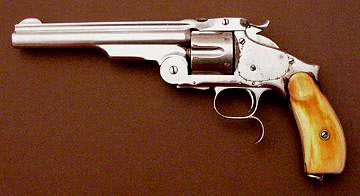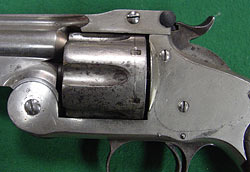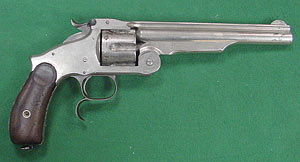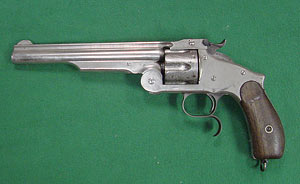
|
|
Russo-Turkish War of Liberation 1877-1878 Chapter Three - Small arms of the warring states - Russia "Smith&Wesson" Revolver, model 3
During the Civil War in the United States, the Smith & Wesson Co. produced revolver models 1, 1 ?, and 2, which were generally not quite successful. Model 3 was constructed by the two armourers Horace Smith and Daniel Wesson after the Civil War, when it was needed to have a cartridge revolver. The two arms smiths used some advanced principles in the construction, for which the companies had to buy off the patents. It was particularly the star-like extractor of cartridge cases (Dodge, 1865), the Gibson's lock (1860), and the mechanism for the cylinder movement. The company's collaborator, Charles King, one of the most competent American arms constructors of his time and the author of other arms systems, among which were Volkanic and Winchester, had also worked on the initial samples of the revolver.1 The Smith & Wesson model 3 was patented in 1869 in England and the United States. For that reason, it is often referred to as “model 1869” for conciseness. In the next ten years, however, it was further developed and improved with the participation of the Russian arms constructors and representatives in the United States General Major Gorlov and Captain Ordinec.2 The first serial Smith & Wesson model 3 with 44 bullets with rim fire, “American”, was produced in May 1870. The US board of small arms evaluated it as “better than any other revolvers produced hitherto” and had recommended the use of bullets with central fire of the same caliber. By the end of the year, the Smith & Wesson factory in Springfield, the state of Massachusetts, had produces 400 pieces of model 3. On December 28, 1870, the factory was awarded the first governmental order for 1,000 pieces, which were produced by March 1871. The rise of the Smith & Wesson and its transformation from a small manufacturer into one of the biggest world arms companies was related to its cooperation with Russia. In 1870-71, the Russian military representative General Gorlov was at the Colt factories in Hartford to control the production of 30,000 rifles Berdana 1. The company Smith & Wesson sent to him model 3 as a proposal. Following its testing in Russia on May 1, 1871, the Russian government made the first order for the production of these revolvers. One supply of 20,000 revolvers was produced and delivered to Russia from December 1871 throughout 1872.3 The Russian king Alexander was also involved in the order. During his visit to the United States, on 6 December 1871, he visited the Smith & Wesson factory where he received as a present a richly engraved revolver of the same model with handle encrusted with pearls. This valuable present at the cost of 400 dollars proved to be a good investment for the company. The king was also informed of the high evaluation given by the famous hunter Buffalo Bill. The orders and the cooperation had increased; the revolver was well received in Russia. Thanks to the payments effected in Russian gold, the situation of Smith & Wesson had radically changed and the company was placed among the few big arms producers. Some arms historians have mentioned the participation of Russian arms specialists in the development of model 3. The outer appearance changed, mainly as regards the handle, the extractor, the cylinder lock, the barrel lock, the extra lock of the firing pin, the front sight, the closing gusset. The revolver had developed into first, second and third Russian model. Due to this improvement, licenses for its production were bought in Europe as well.4 New ammunitions were constructed for the Russian revolver. General Gorlov and Captain Ordinec constructed new and more efficient ammunition with the help of specialists, from the company. They increased the bullet weight with 1.8 g and decreased the gunpowder with 0.13 g. The new cartridge gave to the bullet initial speed higher with 30m/s. The cartridge got a new name different from “44, American”. Russian cartridges were produced also in the Petersburg Cartridge factory, in Germany, and elsewhere. The bullet weight in the Russian cartridge was 16 g, the weight of the gunpowder was 0;32 g and the bullet's initial speed was 232 m/s; the cartridge case was prepared for multiuse; the bullet was made of lead.5
|
Mannlicher ©2003-2004. All rights reserved. No part of this site can be reproduced in any way without the explicit permission of the authors.






